
In Search of Lost Vanguards
Excavation and Space Exploration in Constructivist Architecture
Red Planet Mars
"This is a hole. It always has been and still is. But now it is a hole into the future. We’re going to dump so much through this lousy hole into your world that everything will change in it. Life will be different. It’ll be fair. Everyone will have everything he needs. Some hole, huh? Knowledge comes through this hole. And when we have the knowledge, we’ll make everyone rich, and we’ll fly to the stars, and go anywhere we want. That’s the kind of hole we have here."
Arkady & Boris Strugatsky, Roadside Picnic
A Cold War B-Movie of the '50s depicts our nearest planet in the Solar System as a hive of filthy Commies. Aficionados of such things will know this isn’t as silly as it sounds: the history of interstellar Marxism probably begins with Red Star , a 1900s novel by Bolshevik theorist and scientific-artistic tinkerer Alexander Bogdanov . Yet HG Wells' original Martians are, it should be remembered, a fantasy of anti-imperialist revenge. Wells was outraged by the British Empire's extermination of the aboriginal population of Tasmania, and his alien invasion is a way of inflicting the very same treatment--obliteration by a more technologically advanced society--upon the West. In this sense, it's not quite so surprising that one of the war cries of the Russian Futurists was The War of the Worlds' Martian roar 'ULL-AA', which would in 1919 provide the title for one of Viktor Shklovsky's manifestos for the alienation effect, 'Ullya, Ullya, Martians'. In order to truly estrange , to provide the distance from everyday life’s stock responses and learned indifference that, for Shklovsky, is the key element in great art (be it Tolstoy or the circus), the alienation effect is taken literally to mean the visitation by the alien nation. Shklovsky writes of an avant-garde work being 'worthy of my brothers, the Martians'. This is what much of the Russian Avant-Garde saw themselves as. Like Tatlin's Third International Tower , whose iron legs and perpetual motion are akin to the Martians' walking tripods, this was something as fearsome, uncanny and technologically terrifying as the alien invasion, and intended to be every bit as threatening to existing society.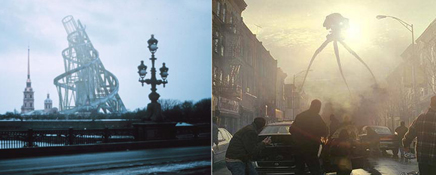
digital realisation of Tatlin's Third International Tower juxtaposed with The War of Worlds (2005)
A history of the Soviet avant-garde could be written through its aspirations to the interstellar. It would run through, after Shklovsky and Velimir Khlebnikov's 'Trumpet of the Martians ' to Iakov Protozanov's 1924 film Aelita, Queen of Mars . This was one of the first Constructivist built environments, housing the Martian despotism that the earthlings bring to revolution. The set by Isaac Rabinovich is made up of angular, glassy polygons, with the painter and Constructivist architect (for a temporary pavilion erected in 1923) Alexandra Exter's costumes adding an inorganic sexuality to the proceedings. This was socialist space opera, with robotic guards, romantic heroines and class struggle in the Martian City. It could go from there to Georgy Krutikov's Flying City four years later, a comprehensive plan for an architecture capable of traveling through the air; or Kasimir Malevich's Planits , an abstract interstellar architectonics of Suprematist forms in abstract space. Even the Soviet space program, long after the vanquishing of the avant-garde, fulfills many of these utopian promises.
In that case, one could look at the remnants of the avant-garde project that litter the former USSR as the detritus left by the Martians: the incomprehensible, incommensurable ruins of a strictly temporary visitation by creatures not like ourselves. The Strugatsky Brothers' tremendous 1972 novel Roadside Picnic depicts just such a visitation. A city that has been 'visited' is left with the Zone in the area where the visitation took place: a fenced-off, contaminated and ruined area, marked by scatterings of bizarre and technologically fantastic objects left by the alien visitors. The Zone is a dangerous, melancholy place, an industrial district where the chimneys no longer give off smoke, visited by strange climactic phenomena, with a stretched sense of time. Within it, however, is quite literally the answer to all human wishes, something which in the last instance holds the promise of eternal happiness for all humanity.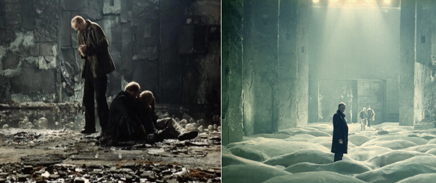
film stills from Stalker (1979)
Filmed by Andrei Tarkovsky in 1979 as Stalker , the Zone is visualised as a Chernobyl-like scarred, postindustrial landscape of ruins, waste, rubbish, of the remnants of industrial civilisation corroded, dilapidated and rapidly being reclaimed by nature . Tarkovsky's version of the Zone has gradually, over the last thirty years, become the foundation of an entire aesthetic. If Modernity, or Modernism, is our Antiquity, then its ruins have become every bit as fascinating, poignant and morbid as those of the Greeks or Romans were to the 18th century. Tarkovsky’s Zone is in some ways specific to the former USSR and a few locations in Estonia, yet practically every industrial or post-industrial country, has something resembling the Zone within it. Such an area would be, for instance, the remnants of industrial districts of East London. Beckton, Woolwich, Stratford, outposts marked by the cyclopean remains of silos, gasometers, factories. These are the places that inspired the Modernists of the 1920s: every manifesto from Le Corbusier 's Vers d'une Architecture to Moisei Ginzburg 's Constructivist response Style and Epoch had their lovingly photographed silos and power stations. Appropriately, also in the Zone can be found the bastard children of the Modernists, the scatterings of overambitious social housing, with their crumbling highrises and streets in the sky. These are remnants of something as alien and incomprehensible to the seamless mallscape of 21st century Capital, or the heritage Disneyland of European Urbanism, as Shklovsky’s Futurist Martians were to their contemporaries: only here without any of the insurrectionary promise of a new world, merely the ruins of a defunct future.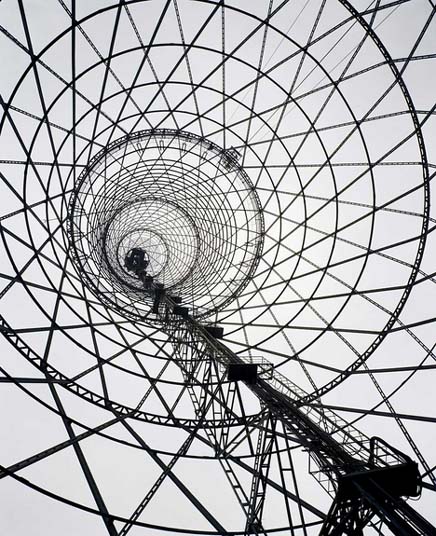
Vladimir Shukhov, Shukhov Tower, 1922, Moscow, Russia. © Richard Pare, 2007.
Theories of Ruin Value
'Half ruined buildings once again take on
The look of buildings waiting to be finished
Generously planned: their fine proportions
Can already be guessed at: but they still
Need our understanding. At the same time
They have already served, indeed have already been overcome. All this
Delights me.'
Bertolt Brecht, 'Of All the Works of Man'
So we have here, via these two models of alien visitations in the imagination of Russian Modernists, whether of the 20s or the 70s, two competing models of Modernity. On the one hand, the advancing, gleaming, ruthless aesthetics of Futurism, particularly, for our purposes here its mutation into the more humanist, politicised Constructivism. On the other, an aesthetic of disintegration, of the aforementioned Futurist world's gradual descent into an overgrown, poisoned wasteland. Both are, of course, spaces that can be found easily enough in any 'developed' country, and both have both revolutionary and reactionary elements.
This divide is presented most poignantly in the architectural photographer Richard Pare's magnificent project The Lost Vanguard . Selected out of an archive of 10,000 photographs, this is a documentation of Modernist architecture in the USSR from 1922 to 1932. Pare approaches the subject matter like the Strugatsky brothers' Stalkers, making journeys into the dilapidated working class quarters of the former Soviet Republics, bargaining for passes into military-industrial sites, and returning with depictions of exquisite objects that have, no doubt, seen better days. The book is, essentially, the final meeting point of the two poles of the Soviet Modernist aesthetic--the gleaming, seamless surfaces, revolutionary optimism and technocratic zeal having long since been overtaken by weathering, their concrete cracked, their artificial, glaring paintwork faded and crumbling and the technical rhetoric shown to conceal medieval construction techniques. Yet the archaeological scale of Pare's project is equally remarkable: an entire illustrated history of a country's Modernist architecture, which easily rivaled in its formal brilliance and the totality of its scope the 'classical Modernist' (and very well upkept) German and Dutch work of the 1920s and 30s.
At the start of T.J Clark's Farewell to an Idea , the author imagines a series of Modernist relics being chanced upon by an archaeologist: a Picasso, a sketch of binoculars, and most interestingly for our purposes here, a photomontage by John Heartfield for the Arbeiter Illustrierte Zeitung, a German language Communist Party glossy. This, 'New Man, Master of a New World', was in celebration of 17 years of the USSR. A huge, weathered face, with tears in its eyes, is centre of a photomontaged landscape of industry, mass mobilisation and Modernist architecture--some collective housing blocks, and the newly built 'Palace of the Press' in Baku. This near-incomprehensible montage would nonetheless speak of Modernism’s poignancy, its political commitment, and its harnessing itself to a highly ambiguous industrial modernity. And, Clark points out, more likely to survive than the depicted artefacts in Heartfield’s montage. 'No doubt, the Baku Palace of the Press, if it survives, is as overgrown and labyrinthine as Shelley's dream of Rome.'
Semen Pen, Palace of the Press, 1932, Baku, Azerbaijan. © Richard Pare, 2007.
Well, Pare has been to the Baku Palace of the Press, designed by Semen Pen in 1932 and what is now Azerbaijan, and several pages of The Lost Vanguard are devoted to it. In fact, it's one of the better preserved of the buildings depicted here: its render might be chipping off, and the interior is stained and filled with seemingly random piles of burnt-out rubbish, but the pressing plant seems in pretty good condition, and the building’s silhouette, with its dynamic, curved balconies and roof garden looks as impressive in Pare's photographs as it did in Heartfield's montage. Elsewhere though, this is a tale of utter devastation. A few pages later, again in Baku, is the Shaumian Settlement, a workers’ housing project: described by Pare as ‘relatively well preserved’. A more astonishing Modernist wasteland would be difficult to find: huge swathes of the blocks are stained and rotting, and the central area is a blasted hole, yet the ambitiousness of the settlement is still visible: jutting, curved loggias, a bright, imaginative colour scheme, a clear-eyed promise of ex nihilo socialist modernism. Or a couple of pages after that, there's two Workers' Clubs by Leonid Vesnin in the same city. Stark, sheer faces of blank render broken up by tiny windows and curved stair towers. Abandoned, both of them look entirely alien: Modernist and almost medieval in their simplicity, seemingly without architectural precedent, and left to the mercies of the elements. As in the Zone, time goes haywire: they could have been there forever as much as they appear to have been designed last week.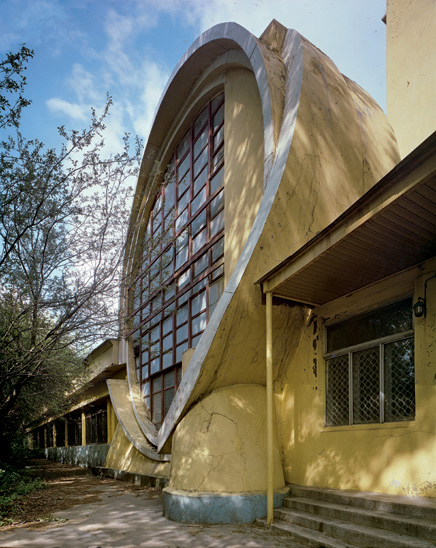
Konstantin Melnikov, Gosplan Garage, 1934-6, Moscow, Russia. © Richard Pare, 2007.
In contemplating these images however, one is reminded of the interesting element to Albert Speer's otherwise utterly banal 'Theory of Ruin Value' . Not the bit about the impressiveness of ancient ruins, and the need to leave similarly imposing remains. Rather, the psychotic, suicidal notion of building with the ruins already in mind: a death-drive architecture, where posterity's opinion is internalised to such a ludicrous degree that, in a sense, the corpse has been designed before the living body. Pare's introduction makes a point which touches on this Speerian madness when he describes chancing upon the carcass of a Factory Kitchen in St Petersburg, designed by architects from the avant-garde group ASNOVA . Every single part of it that can be has been taken for scrap, from windows to steel reinforcement: in an especially Stalker-esque moment, the photographer disturbs a group of people sat around a fire made up of the building's remains. The gutted carcass, he points out, finally resembles the architects' original concept. Bereft of the adverts, additions and disfigurements imposed on many other structures, this is the Platonic form of the building, as much as it would have been in the original drawings, the purity of the death mask's lines more clear than those of the living building would be. This, the implication might be, was its inevitable final form.
There's another archaeological element here which points to this book's truly immense importance for the history of what, with appropriately Homeric epithets, is generally known today as 'heroic' or 'classical' Modernism. This is perhaps the most comprehensive unearthing of Constructivist architecture ever published in the English language, and has a good claim to be the most complete produced anywhere else. Yet, Jean-Louis Cohen 's historiography of the period in the introduction makes clear that at the time they were built, these were objects of proud, and successful, international propaganda. Leading western Modernists were subscribers and sometimes contributors to Soviet architectural publications like ASNOVA News or SA (Contemporary Architecture). Soviet developments were at the heart of the early CIAM , and the Soviet Union was generally seen as the only serious rival to Weimar Germany in the intensity of its experimentation. Books such as Bruno Taut ’s Modern Architecture , Adolf Behne 's Der Moderne Zweckbau , Karel Teige 's The Minimum Dwelling were all filled with lush illustrations of stark, stunning, and, frequently, built modernist monuments in this vast Eurasian space. Antipodes like Teige and the 'encyclopaedian' Sigfried Giedion used the term Constructivism as a synonym for their version of Modernism. The rise of Hitler led to most of Germany’s leading Modernists literally upping sticks and moving to Moscow, and Mart Stam, Ernst May, Andre Lurcat, Hannes Meyer, Margarethe Schutte-Lihotsky and Bruno Taut were all living in the USSR by 1933. Even Albert Kahn, 'Ford's Architect' was active there, though no doubt for less idealistic reasons.
So the obscurity of Soviet Modernism is a purely retrospective phenomenon. It's a delightful irony that the New York exhibition of Pare's photographs is at New York's Museum of Modern Art , as their International Style book/exhibition of 1932 was the first and most successful attempt to write this movement out of Modernist history. Philip Johnson (a man not known for his socialist sympathies) and Henry-Russell Hitchcock threw patrician scorn on 'fanatical functionalists' who would build for 'some proletarian superman of the future', and included only one Soviet structure in their pinched, mean-spirited selection of white boxes. MOMA director Alfred H Barr had made numerous trips to the USSR and been impressed by its Modernists: they knew this work existed, and deliberately excised it in order to present a Modernism less threatening to capitalist America. And after the turn to eclectic monumentalism imposed by Stalinist diktat in 1933-4, they would be aided in this by the Soviets themselves, who appeared to be utterly ashamed of their own experiments.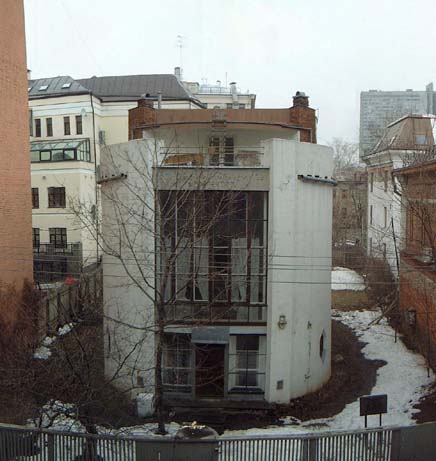
Konstantin Melnikov, architect's home, 1927, Moscow. via
Post-war, even Johnson/Hitchcock's cursory references were absent: a typical history such as JM Richards' Modern Architecture (1953) lists an impressive litany of international modernists of the 1920s-30s, and mentions one Soviet 'architect': the painter Malevich, whose designs never advanced further than plaster models. The work of Anatole Kopp (the unrepentantly Marxist history Town and Revolution , 1967) marked the first blow to this Cold War orthodoxy, then the brilliant work of Catherine Cooke in the 1980s-90s revealed both the extent of Soviet Modernism and translated its fervent theoretical debates. The translation, meanwhile, of Selim Khan-Magomedov's Pioneers of Soviet Architecture in 1988 presented a huge quantity of work scattered across this vast territory, surpassing Pare's later researches in scope.
Nonetheless, most histories of Modernism, in particular the rash of publications in the last 4 years, are quite comfortable about ignoring or dismissing the Soviet experiments. A few drawings or models: Tatlin's tower, the Vesnin brothers' Pravda building with its glazed lifts, maybe Melnikov's built house and Workers' clubs are always outnumbered by the reassuring Western structures which have been lovingly restored over the last 20 years. So, via Pare's journey through the ruins, it's time to take a close look at what exactly was built, the ruins and wrecks and occasional well-kept up remnants left by the 'visitors' that pervade the former USSR, and then another look at those wildly ambitious unbuilt, unbuildable utopian projects that, to misquote El Lissitzky , suggested an architecture for interstellar revolution.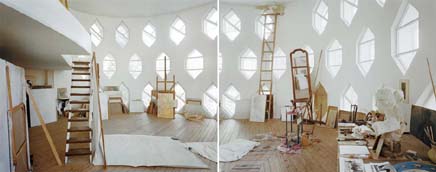
Konstantin Melnikov, architect's home, 1927, Moscow, Russia. © Richard Pare, 2007.
The Revolution of Everyday Life
'A planetarium appeared in Moscow.
This was an enormous fantastical apparatus. It was the – realisation of his fantasy.
Made of black metal and glass.
With forms that resembled no living creature.
It was called the 'Martian'.
It made him continue to search and search for a fantastical reality.
Or for the fantasy in reality.'
Aleksandr Rodchenko, Black and White--Autobiography
In 1929, the Moscow Planetarium , designed by the Constructivists Barsch & Sinyavsky, was completed. This was intended as a temple to popular science, offering visible proof to atheism and demonstrating the wonders of the Cosmos. A Planetarium had never been so politically loaded. In the late 30s, Rodchenko, confused and disappointed by Stalinism, recalled his pride at photographing this cosmic complex. The Planetarium survived Stalin and the anti-scientific lunacy of Lysenkoism , lived out the loss of the space race and survived the neoliberal chaos of the 1990s, and then finally fell last year to Moscow's Mayor Yuri Luzhkov. The Moscow Architecture Preservation Society 's detailed, dispiriting report Moscow Heritage at Crisis Point lists it as a 'lost' building: its glazed external staircase removed, its dome arbitrarily raised, its interior gutted. As if to make totally clear that this was a victory for the Restoration, Luzhkov had an Orthodox Priest bless the opening ceremony of this 'reconstruction'. An attempt at the interstellar quotidian was finally defeated.
Today, the aesthetics of everyday life are provided by ultra-conservative developers (the likes of Barratt Homes in the UK) and the aesthetics of Art or Commerce by the avant-garde of a few decades ago (from Foster to Koolhaas). The remarkable thing about Constructivism, something that can still be seen as a shadow in Pare's work, is that the everyday was so frequently the area for experiment. A much-used Russian term here was Byt , translated usually as Everyday Life, specifically in its most habituated, domestic sense. So most of the projects here were applications of the aesthetic that would be branded 'alien' by the Stalinists to the most basic architectural elements of society. That is, housing, public leisure facilities, schools. Equally frequently, there were administrative or industrial buildings. Although even these were often in the poorer quarters of cities and towns, the growing nomenklatura’s presence is unavoidable.
Superficially, these buildings might seem similar to corresponding Western models: social housing, working men's clubs and so forth. So it's the differences that are especially key here. This was frequently a teleological architecture, one could even say a Pavlovian one: particular social affects were intended to be produced. Although a socialist state power of some sort was claimed (rightly or wrongly) to be in place by 1922, its leaders were well aware that old habitus died hard: religion, patriarchy and 'petty bourgeois' attitudes still pervaded. In 1924, Leon Trotsky , a few years before his expulsion, published a book called Problems of Everyday Life . Here there was a cautious endorsement of 'Byt reform'--the experiments in living being carried out at the time by communes and co-operatives--and the particular material forms that might house them. 'Public laundries, public restaurants, public workshops' would take the place of all that used to take place in the kitchen, thus abolishing 'household slavery'. A poster from around this time shows a dingy, cramped kitchen being opened up to a glittering, glassy new world of futuristic structures and open space, and this was what was, tentatively, being constructed at the time.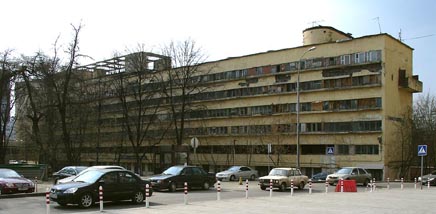
Moisei Ginzburg and Ignati Milinis, Narkomfin Building, 1928, Moscow, Russia. NVO , 2007.
The Constructivist group OSA had a phrase, the 'social condenser' to sum up the particular effect and process that their architecture was intended to induce. The Narkomfin Building , designed by Moisei Ginzburg and Ignati Milinis in 1928 for employees of the Commissariat of Finance, is the most famous and conspicuous of these buildings for a new Byt. Richard Pare devotes more pages to it than anything else, fittingly, as its aesthetic panache and current putrefaction are roughly equal. Unlike some of the other ruins, there is an active campaign to save Narkomfin--and the defunct duplexes get thorough treatment in Moscow Heritage at Crisis Point. What we have here is a long, ribbon-windowed block, connected by a covered bridge to a glazed collective compound. The structure was designed to induce collectivism in its inhabitants: the duplex flats were divided into K-Types, which still provided space for children and cooking, and the F-Types that were 'fully collectivised ', assuming that the children would be brought up in the collective block and the tenants would eat in the adjoining restaurant. The glazed block would feature all the facilities denied from the individual flats. Yet almost as soon as it was finished, the Narkomfin was denounced a remnant of 'leftist' utopianism, the pathos of one of Charles Fourier's phalansteries somehow cut adrift in Stalinism. A fate equally melancholic has met the 'fully collectivised' Dom Kommuna designed by Ivan Nikolaev for the Textile Institute, designed around the same time , which seems to be not so much crumbling as wilting.
Yet only 4 years earlier, these were some of the first products of an intended standard for the whole of Russia. Ginzburg, along with other architects from the OSA Group, was employed by the state to develop typologies known as the Stroikom units. The F-Type and K-Type flats were pioneered here, as well as the adjoining public facilities: the high ceilings and duplexes were considered usable as a general standard for all, as opposed to a chic luxury. The rise of Stalin and the accompanying mass industrialisation actually killed off this exercise in Standardisation rather than encouraging it, and only 6 complexes applying these principles were ever built (which still beats the amount of Unites Le Corbusier managed to get built 20-30 years later, borrowing many Stroikom ideas). The Lost Vanguard features one of the others, by Ginzburg and Alexander Pasternak, in Ekaterinburg. In rather better condition than the Narkomfin, its alternation of glazed strips, curves and sharp angles still looks like a viable, if ghostly, standard. It's curious pink hue reminds that the white box International Style that archive photos give these buildings was often an illusion: the OSA architects were great enthusiasts for bright, artificial chromaticism: a whole issue of their journal, SA was devoted to the question, and the Bauhaus' colour expert Hinnerk Scheper was in the USSR at the time collaborating on their projects.
Although the Platonic white still got a few applications, appealing in its ability to sweep away the clutter and waste of the past. A wonderful anecdote in a contemporary womens' magazine featured a woman using a whitewash gun in a new Dom Kommuna 'because it shoots the old Byt dead!' Other, less ambitious housing blocks are scattered across the pages of The Lost Vanguard , implying that this was every bit as important a matter here as it was for the German Neues Bauen, if rather less dogmatic: strange motifs abound, such as the half-arches of Nikolsky/Gegello/Simonov's Tractor Street flats in St Petersburg, or the jaggedness of a doctors' co-op in Kiev. Occasionally the lightness and airiness is replaced with something more imposing and sinister, such as in Boris Iofan's bombastic Constructivist-Classical House on the Embankment in Moscow, later known as the 'house of ghosts' for the amount of old Bolshevik residents who were purged.
Then there are the public buildings: the factory kitchens and workers' clubs. Most wildly impressive are the three collective kitchens designed by ASNOVA architects for St Petersburg. ASNOVA was the most 'formalist' of the avant-garde groups, and their past of designing floating restaurants and skyscrapers has more than a trace here. One of them, as mentioned above, is now a thoroughly picked carcass: you can make out that the new world was built partly in wood. The Workers' Clubs were a Bolshevik pet project, intended to provide, as Trotsky put it in 1924, a 'bridge' between the old world and the new: 'leading out of the close little cage of the family flat with its ikons and image lamp' into socialist citizenship and culture. However the most famous were projects of the Trade Unions, which had a precarious independence--Konstantin Melnikov's series of clubs in Moscow were all for the unions, and repudiated standardisation in favour of individual works of art, with the most famous of them, the Rusakov Club (one of the 2 or 3 Constructivist buildings that has some sort of international fame) a still astonishing conflict of tension and force--'a volley aimed at the future' as he called it himself.
El Lissitzky, at one time an ASNOVA member, wrote that the club would not be places where people passively consumed entertainment: 'the important thing is that the mass of the members must be directly involved. They themselves must find in it the maximum of self-expression.' The architecture was intended by some to help inspire this expression, as perhaps in Melnikov's clubs or in Ilya Golosov's justly famous Zuev Club, while the OSA social condensers, like the Vesnin brothers' labyrinthine Palace of Culture of the Likachev Works, might have had more directly byt-transformative intent: its volumes have been compared to Wright's Guggenheim, similarly announcing the immediate existence of the new world.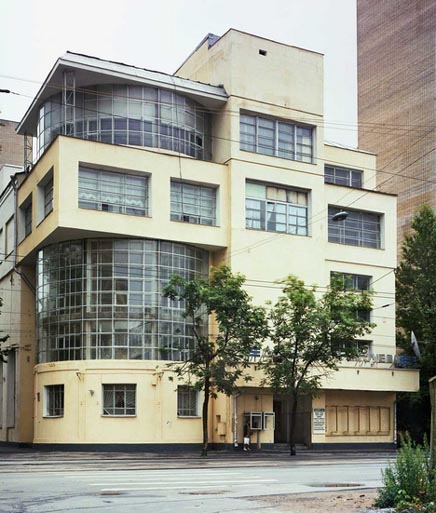
Ilya Golosov, Zuev Workers' Club, 1926, Moscow, Russia. © Richard Pare, 2007.
The most breathtaking of all the projects photographed and profiled has to be the Gosprom Complex (or 'Palace of Industry') in Kharkov in the Ukraine. There can't have been anything else of this scale and ambition anywhere else in Europe at the time: indeed, it resembles more some particularly ambitious work of the late 1960s than the mid-20s. Constructed between 1926 and 1928, apparently by volunteers from the local Komsomol, this is Metropolis --or Aelita --actualised. Concrete and glass blocks from 7 to 13 storeys connected by skyways, curving round a huge public square, this resembles a small city in its own right. Its designers, Serafimov, Kravets and Felger, appear to have been as obscure at the time as they have been since, yet only an El Lissitsky, a Gropius or a Corbusier was designing anything like as ambitious in 1926. The Futurist Vladimir Mayakovsky unsurprisingly saw it as a herald of not so much a new Byt but of a transfigured planet. Eisenstein and Vertov both used it on film (The General Line and Three Songs of Lenin , respectively), perhaps because its contrasts, angles and multiple levels offered a spatial equivalent to their montage techniques: Friedrich Ermler used it in Fragment of Empire , a sort of Red Rip van Winkle tale, as exemplar of the incomprehensible new world that the sleeper awakes to. Pare's pictures seem to pay tribute to these directors in their sharpness and disjunction: inspired also perhaps by contemporary shots of the complex, like Georgy Petrusov's 1928 'New Building'.
There are innumerable other fragments and interventions in Pare’s book, too many to list here, their degeneration too extensive to itemise. A few scattered masterpieces worth mentioning: a remarkably avant-garde water tower in Ekaterinburg proudly atop a post-industrial waste; an incredible diving board in Kiev looking down into a drained pool; a series of clubs, kitchens, flats and the elegant hammer & sickle topped Kirov District Soviet in Narvskaya Zastava, St Petersburg; great lost and forlorn buildings by Corbusier and Mendelsohn…If there was an orthodoxy here then it’s a style of long fenestration bands broken by graceful curves, like a more generous International Style, and this can be seen from Baku to Kiev. Most gorgeously, in Sochi on the Black Sea, with three sanatorium complexes both preceding and rivalling Aalto's breakthrough at Paimio . One of these, by the Vesnin brothers, recently became a base for soldiers serving in the dirty war in Chechnya: Van Damme posters rather than Constructivist exhortations adorn the walls. This reminder of state brutality is not an exclusively contemporary phenomenon: some of these buildings housed the courts and police offices that would sentence hundreds of thousands of innocents to their deaths, while a fair few social condensers were designed for 'Chekists': secret policemen, members of the NKVD, whose socialist morality was presumably in need of encouragment from the architecture.
Such a Chekists' Housing Project, in Ekaterinburg, contains an astounding staircase, a spiralling Kubrickian odyssey upwards. In fact, perhaps the most original feature of most of the buildings here seems to have been their stairwells and ramps, a hallmark of what Lewis Mumford would no doubt have considered a 'sun-worshipping' culture. All of them seem to curve, cantilever and vault upwards as if aiming, in Malevich & Kruchenykh’s phrase, for 'Victory over the Sun'. Even the more modest, sober structures (such as a deco-esque school in Ivanovo) seem to sheath some kind of interstellar passageway. The shots seem consciously to pay tribute to the original charters of these thrusting spaces: one of the Nikolaev Textile Institute's geometric stairs seems to pay tribute to Boris Ignatovich, while the photograph of internal ramps at Corbusier's Centrosoyus make his abstract theories of 'circulation' seem a stunningly fluid reality. This is an architecture of perpetual motion, which makes it especially poignant that it so quickly ground to a halt.
The Institute for the Transformation of Mankind
'While undertaking to expand the scope of architecture, I surprised myself and will surprise all of you by my arithmetic: one third of life is spent lying without consciousness, without any guide in the mysterious world of sleep, and tapping the unseen depth of the source of healing secrets...well, this may be the miracle of miracles, indeed anything can be a miracle.'
Konstantin Melnikov, The Green City
Unavoidable in any discussion of this architecture is just how short-lived it all was. Although the time period here is '22-32', most comes from 27-32, the period in which Stalin picked off his opponents, first on the Left then on the Right and launched a murderous collectivisation in the countryside and the planned industrialisation that took the country from reaping with sickles to Sputnik . There was brief encouragment given to Constructivists in the short-lived 'cultural revolution' that accompanied the first Five Year Plan . By the time that was finished (in four years: 2 + 2 = 5, as the slogan went) most of these buildings were already antique, associated with a 'Trotskyist' or 'bohemian' or, indeed 'alien' approach: hence, they never had the opportunity to be truly lived-in, never became accepted by the population at large. After being briefly a wing of state propaganda, they became an embarrassment, frequently refaced with stone and ornamentation.This, nearly almost as much as Cold War politics, explains their obscurity, but so, perhaps, does the huge amount of paper architecture in the period. Best to think about the untainted, ahistorical utopian blueprint than the actual constructed reality.
For all that, no paper architecture had been this exciting, or would be again for decades, and no discussion of the period is complete without it. This, though, is where the alienation effect lessens somewhat: anyone interested in 20th century architecture has seen a reproduction of Tatlin's tower, and its familiarity enables it to be slotted into a series of cliches about utopian dreams or the oh-so-poignant hopefulness of the revolution before it starts to devour its children. Nonetheless, let's leave reality behind for a bit and return to the productions of Red Planet Mars. J Hoberman described Aelita as 'interplanetary Trotskyism', and maybe the best book to document the paper projects is El Lissitzky's Russia: an Architecture for World Revolution , written in German in 1929. Drawing heavily on the experiments of the 'Soviet Bauhaus' Vkhutemas/Vkhutein , this was quite in contrast to the Stalinist policy of nationalism and secrecy. As the title implies, this was an internationalist tract, showing the Soviet examples as exemplars of what a revolutionary architecture could be like everywhere.
El Lissitzky, photo-montage of Wolkenbugel, 1925
Some of the most daring projects here came out of ASNOVA, and had already attracted international intention, perhaps because they seemed to be designed for technologies far beyond Russian capabilities. Nikolai Ladovsky's workshop at the Vkhutemas school harnessed a 'psycho-technical method' to an explosive interpretation of the skyscraper vocabulary. And also to some peculiar restaurants and hotels hanging from peaks or desending down slopes: Zaha Hadid's The Peak from 1981 took obvious tips from these designs. El Lissitzky's own horizontal skyscrapers for Moscow, the Wolkenbugel (skyhook), have a similar afterlife: Koolhaas' CCTV building in part seems a willfully irregular use of the idea. The student projects from Vkhutemas are like a meeting point between the Neues Bauen and Buckminster Fuller: take Ivan Leonidov's Lenin Institute, a glass ball suspended from a tower full of books. Leonidov's town-planning projects and unbuilt clubs, profiled extensively in Kenneth Frampton’s Critical History and long since a touchstone for Deconstructivists, have been related to Malevich's Suprematist painting: accordingly, Malevich's own 'buildings' are in Lissitzky's book, three dimensional interstellar architecture ('planits') made up of squares and rectangles, taking the stepping of New York skyscrapers out of the zoning code and into the future…much of this was literally science fictional, as some basic Western building techniques were rare in the USSR. A skyscraper was as improbable in 1923 as Krutikov's Flying City would be 5 years later. This project (another product of ASNOVA's atelier at Vkhutemas) merely takes literally a SF socialism implicit in the more seemingly buildable projects.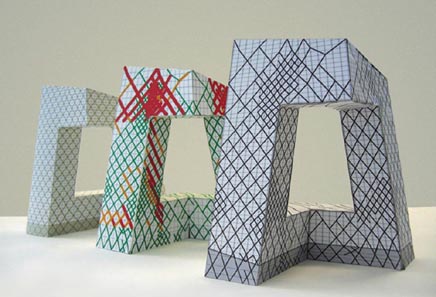
OMA, models of CCTV, 2006
Curves and cylinders were, as in the built projects, constant motifs, only here with even more explicit interplanetary content. Alexander Nikolsky's bathhouse for St Petersburg, a glass dome probably unbuildable even today is one extreme example, as are what appear to be extraterrestrial siedlingen by one Kotschar at Vkhutemas: a few row houses straight out of the Neue Frankfurt catalogue aligned with towering rotundas. Similarly, Lissitzky's book has an office complex by Siltschenko, another student, made up of the same--again, more 60s than 20s in immediate appearance, akin somewhat to the Capitol records tower in fact--arranged into a ringed square. Even Metabolism seems to be anticipated in the additive towers of Varenzov's 'Wohnsysteme in der Zukunftstadt'. Not in Lissitzky, but equally space age was a design for a headquarters for the Communist International by Lydia Komarova, made up of spiralling glass cylinders: politically as well as technically this was dangerously utopian, as World Revolution was decisively off the agenda under Stalin. However it was partly because of Lissitzky's book that the Neues Bauen transferred itself eastwards en bloc--they'd expected the new world to be already awaiting them, rather than fighting a rearguard action against medieval technics and a philistine bureaucracy. One flaw of Pare's book is that it doesn’t go to the new towns planned by Ernst May (Magnitogorsk and many others), or offer any insight into what, if anything, ever actually got built by Taut, Meyer's 'Bauhaus Brigade' or Lurcat in their Moscow years. Perhaps there's nothing left. May, after all, claimed that he was lucky to escape with his life when he and the other German 'specialists' were hounded out in the mid-30s.
The other key book for the migrants was Sotsgorod ('Socialist City') by Commissar Nikolai Milyutin, occupier of the Narkomfin penthouse: a proposal for linear cities: and the post-war new towns can trace themselves back to the likes of Magnitogorsk, disavowed though that might be. The controversy over the socialist city broke out in 1930 over the 'Green City' competition for a sort of spa town outside of Moscow. Melnikov's proposal was taken as a satirical jibe, a city of sleep for a country descending into coercion and surveillance. The inhabitants' sleep would be subliminally affected by smells, sounds and spatiality so that even in dreaming they were reachable by the authorities; yet Melnikov seemed breezily naïve about his proposal, and at the centre of it he placed an 'institute for the transformation of mankind'. But a phrase like 'and what’s more, the whole world has fallen asleep' in his accompanying explanation seemed dangerously ambiguous.
The contest here highlighted two competing town planning ideas among the avant-garde. The first was 'urbanism', led by one Leonid Sabsovich. Despite the name, this was basically a version of the garden city on a massive scale, with huge collective blocks dispersed across the countryside. Extending the 'social condenser' idea to whole cities, this was a particularly utopian kind of urbanism, in which marriage and property would be obliterated at one stroke, an architectural Sexpol in which 'divorces' were achieved by the moving of a partition. But more important for Western Modernists, especially in the CIAM, were the proposals for disurbanism. The sociologist Mikhail Okhitovich had converted Moisei Ginzburg, a member of CIRPAC, the CIAM's central committee, and most of the OSA Group, to a radically dispersed notion of city planning. This was a response to a situation in which the city and country were virtually at civil war, and huge primitive accumulation led to cities acquiring favela-like makeshift outskirts. Instead of designing new cities or expanding the old, Okhitovich wanted them exploded into vast networks connected by advanced transportation, stretching all the way across the countryside. 'The network would win, the centre would die'.
At this point it's worth looking closely at the disurbanist proposals. While the International Style planning approach, with its zoning and edifices, was purist and Platonic, disurbanist theory was based on fluidity and changeability. In the OSA group journal Sovremennaia Arkhitektura Alexander Pasternak wrote that the fixed house was an 'anachronism, apathetic and out of place, no longer an active participant in an active and fast moving life'. The houses being developed by the OSA at this time were prefabricated, both easy for people to assemble and dismantle, and were intended to be provided by the state to individuals who could do whatever they liked with them: Moisei Ginzburg's prototypes could additively make two linked houses, or put together to make a communal block if the inhabitants so wished. SA declared that the notion of a building built to last was henceforth over. Another prototype, based on a Vkhutemas diploma project by Sokolov was for cylindrical pods placed in untamed countryside. This was an extreme of collectivism, with a total abolition of private property and extension of communal facilities, and at the same time an extreme of individualism, with each person having their own single dwelling, whether male or female, in a couple or not: a 'pod of one’s own', as it were. The plan of these settlements was in the form of interlinked ribbons, each one representing a strip of industry, agriculture, transport, cultural facilities and housing.
When these proposals were across at the Green City exhibition in 1930, Le Corbusier was asked to give his views on the projects: this would become the Response to Moscow , later retitled The Radiant City . The final form of this book dwells often on the follies of Soviet disurbanism. Private letters between himself and Moisei Ginzburg from 1930 showed that this was a debate in which Corbusier was the collectiviser and the Soviet architect the individualist, even though Ginzburg wrote that 'you want to cure the city, because you are trying to keep it essentially the same as capitalism made it'. While the Response to Moscow eulogised the Plan, seeing it as a despotic force, a Napoleonic 'tribune of the people', the Soviet disurbanists eulogised a kind of democratic planning in the tradition of council communism. When the collective networks of industry and transport were provided and property was eliminated, then people could live wherever they decided to put their pod. Okhitovich wrote that 'the stronger the collective links, the stronger the individual personality'. This is a conception far from the familiar opposition of on one side the fixed, monolithic plan, as in the CIAM's postwar outgrowths, and on the other the capitalist anarchy of leaving the free market to remake the city in its image. At the same time it suggests an approach to the divide between city and country that has been resolutely untried, despite a few superficial similarities with the LA approach to urban cohesiveness.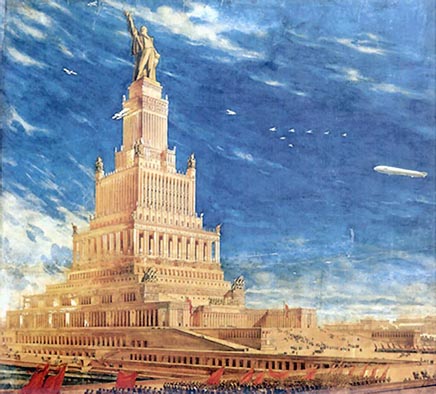
Boris Iofan, The Palace of Soviets, 1933
This is mainly because history would soon catch up these experiments. A CIAM conference was planned to be held in Moscow in 1933. However the Palace of the Soviets competition of that year showed the direction that the rise of Stalinism was taking architecture and planning--a huge, monumental city centrepiece, although most CIAM architects took part anyway, with Corbusier's entry being particularly stunning. An entire book could be filled with extraordinary plans and models proposed here, by everyone from Poelzig to Lubetkin, Ginzburg to Ladovsky. But to concentrate on the big city was the opposite of the OSA's theories. Okhitovich and Ginzburg had advocated demolishing much of Moscow, which would revert to a giant park filled with monuments. Yet here was the capital stamping its authority on the country: the 'cult of hierarchy' that Okhitovich had explicitly criticised. The CIAM did have one small conference in Moscow in December 1932, with CIAM general secretary Sigfried Giedion and others meeting Ginzburg and the OSA group, yet the game was obviously up: the winner of the Palace of the Soviets competition was a huge neoclassical edifice by Boris Iofan , designer of the House of the Embankment that looks so intimidating in Pare’s photographs. Giedion actually sent a telegram and a photomontage in protest to Stalin, which, fortunately for him, was never received. In a letter to Corbusier, Giedion outlined the contradictions of the CIAM's position: opposed to untrammelled capitalism, yet forced to suppress their politics in order to get work. He asked: 'should we be technicians or politicians?' If the latter, it would be 'impossible to have an influence with anyone important at the moment', especially after the rise of Hitler cut off the other centre of Modernism.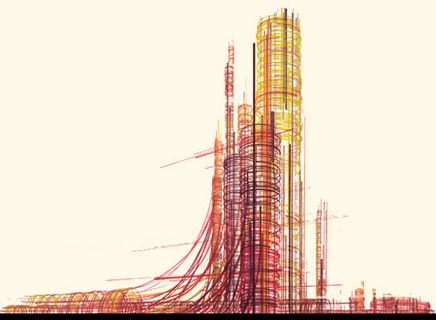
Iakov Chernikov, Architectural Fantasies , 1925-1933
And at this point, the conjuncture in which the Socialist City was the fixation of Modern architects as much as Dubai skyscrapers are for their contemporary descendants was finished. Yet in 1933 was published one of the great last hurrahs of Constructivism, and a return to the science fiction from which it emerged: Iakov Chernikhov's book Architectural Fantasies . The designer was prolific in industry, and at least one factory building survives in St Petersburg (though he's absent from Pare's book), yet was by no means a participant in any of the period's major debates. This perhaps helps leave his plans untainted by history and by the ruination that has overtaken his contemporaries: accordingly, these images, crackling with electricity, depict a garish industrial utopia resembling space stations more than earthbound Dom Kommuny. Barrett Watten has compared these images' technocratic, rhythmic drive to Detroit techno: and there here much the same kind of shuddering fear and anticipation of a new world. Chernikhov wrote of the fantasies as revealing the 'hidden desires' of the architect.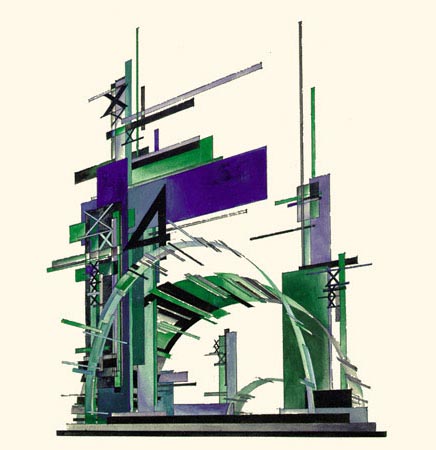
Iakov Chernikov, Architectural Fantasies , 1925-1933
Soon to be hidden because suppressed, of course. Nevertheless, Chernikhov's books became a sort of image bank for high-tech architects in the 1980s, revealing that their employment does not in itself cause the world to be transfigured. When the 'alien building' is a bank or an office block it can become an object of distant, awed contemplation. When, on the other hand, the alien enters everyday life, when it can't be ignored but has to be lived with, then the boundaries between the alien nation and the alienated cities of late, late capitalism can start to fall apart.
cover image from Iakov Chernikov's Architectural Fantasies
Creative Commons License
This work is licensed under a Creative Commons License .
/Creative Commons License
13 Comments
Hmmm.
Amazingly, long and in depth take on the many versions of Russian or Soviet Modernism....
Very informative. I would call it more simply a review of Pare's book....
[it's kinda sad how tarkovsky (and some crew members) died of cancer caused by filming in contaminated locations for stalker, like the sewage tunnels]
Read your informative article with some interest. Unusual to find anybody outside of Russia who knows about the Strugatsky brothers, let alone quote from thier books. You may be interested in documentary film claeed "Architecture and the Russian Avant-garde". Using computer graphics and archive footage the film chronicles and touches on many of the subjects and ideas which you write about and was shot on location in Moscow. The film is part of a series o 6 films about the Russian avant-garde of that period. Have a look at www.copernicusfilms.narod.ru for more information.
The Berkeley Art Museum just finished a retrospective on Russian science fiction films .... From the Tsars to the Stars: A Journey Through Russian Fantastik Cinema
It's a pity that many of these brilliant buildings in really awful condition. Our government has never had money or will to save them.
on magnitogorsk: stephen kotkin, magnetic mountain. stalinism as civilization
other books deal with the architectural avant-garde as a basis for the later "turnover" to socialist realism and stalinist kitsch..., like boris groys's the total art of stalinism: avant-garde, aesthetic dictatorship, and beyond
Thanks for getting through it, everyone. I've spotted those films before, maybe I'll actually get one of them now...
One book I didn't mention here but which is absolutely brilliant on the subject (I read it after finishing this) is Revolutionary Dreams: Utopianism and Experimental Life in the Russian Revolution by Richard Stites, which is brilliant on the aesthetic-SF-utopianism conjunction. But Boris Groys' book I tend to think is pretty awful. His analysis of Socialist Realism and sots art is convincing, but the 'avant-garde' (a term that Constructivists would have been loath to use, incidentally) are travestied - a few quotes from Malevich (who did tend to declare things like 'I HAVE ABOLISHED TIME AND SPACE!' I grant you) and heavy dollops of assertion really does not constitute proof that Constructivists were Stalinists, but you'd think so by how canonical that book has become.
Speaking of a lost age.. I understand that it is very difficult for You to really understand all the implications and effects of the Russian modernism as a whole (architecture, cinema, poetry), because, as a Anglo-Saxon westerner, You are essentially unable to differentiate the meaning from the preconceptions forced upon You by the official understanding of Russia and the reassuring boundaries set by general politics.
This said, one could argue that a great part of meaningful history of twentieth century art was set in motion or moderated by a kind of Russian, i.e. Slavic view of the world (which grew from the people, from the folklore and was molded for centuries,just like in the West), however brief it may seem in any given case.
Take film, for example, or architecture.
I am, in fact, just trying to make clear one point: the West (the "new", Anglo-Saxon west) has not yet really tried, or, which is worse, wanted, to understand "Eastern" art on its own, without stamping it and putting it in a neat drawer (communist, Stalinist,etc). And yet, many of the objective values presented to us today are a direct consequence of actions prepared and set into motion in the "East", that scary, inexplicable void.
For all this, I appreciate Your obvious attempt to "make even", to undo the ideological, political wrongs. But, I can also notice the same echoes of cultural domination, of diminishing, all to familiar.
Thus, we can really rise the question of morality of texts and "programs" such as this, or maybe it is a "victor's" moral that matters.
"Delirious Moscow" offers little help.
Damjan, thanks for the comment. I've been working on Soviet and Russian history in one way or another for around a decade, so please don't imply I'm some sort of dilettante because I'm not from this 'East' which you're disavowing and reinforcing at once. This piece was written from a (pretty undisguised, I thought) Trotskyist perspective, so I'm not sure how the 'official understanding' really applies here, or how I'm trying to draw a 'victor's moral': if anything, I wanted to stress the complexity and openendedness of Soviet Modernism (and indeed Bolshevism in general) before the 1930s, that there were all kinds of possible futures. You might well find that frivolous, in which case my apologies.
As for the main criticism, well: the problem I have is that the Russian Futurists, Rationalists and Constructivists were Internationalists, frequently (Ginzburg, Lissitzky) both Jewish and well-travelled; and what was important for them was internationalism in politics and in aesthetics. Within that there is no doubt a deeply Russian influence every bit as distinctive as that of any other nation, 'moulded for centuries', if you like, and you can see that especially in the work of Melnikov. I don't intend to deny that. Yet if I have subsumed Russian modernists into an international, 'anglo-saxon' (I would think far more a Franco-German one here, but never mind) movement, then that was their fault, not mine.
The art and architecture this piece is written about was so deeply politically and socially involved that it wouldn't want to be assessed outside those categories, or be assessed as a totally autonomous art. Having said that, if you do want a purely autonomous, formalist analysis of these things, there's a lot of it about. It just isn't what this piece was for.
Mr Hatherley,
By no means was my intention to denounce You as some kind of a dilettante. Your text, is, in my opinion, a product of great knowledge of the matter. This is a question of a starting/standing point.
I just wanted to point out my general impression, or strong belief, for that matter; that, in the contemporary Western culture(s), (and they are all nowadays "Anglo-Saxon", weather you like it or not), everything that has roots outside the "natural" and "safe" boundaries, has to be "marked" as "second-rate" or "questionable", even "dangerous" (please note the quotes, to avoid taking this literally), instead (and this is crucial) of being perceived, and studied, as different in their own right, and ontologically autonomous as such, and only then analysed as a part of the whole. I only speak of the same treatment, as ,say, Italian, or Dutch art would have: first the art, then politics. It is a question of criteria.
Every art is deeply politically and socially involved, so it is unfair to always portray (and this is literally almost always the case) the art of the East as being in some "unholy alliance" with politics.
It really is a question of boundaries, but the ones that were set up by the West, and in the 20th century.
And of course that Russia is, and has always been, part of the Western culture, so it really is not a "technical" problem of understanding, but that of a will to attribute "Eastern" cultures their own right to exist and be as important as any other Western culture. The question is, and has to be, political.
All this may sound a little bluntly put, but I can assure You, my ambitions are NOT political, they are merely that of an intellectual honesty to oneself.
I am, really, talking about the cultural climate of the beginning of the 21st century, nothing more, but nothing less.
Of course there are many autonomous, "formalist" if you must, analysis around, and they are not the matter here, they miss the point even more. I am not talking about abolishing politics from the discourse, because it really is important. I am talking about the need of real understanding the reasons of social, political and, in the event, artistic developments in any culture. And of examining those reasons with a friendly gaze.
Best regards.
Also, the question of these artists being Russian or Jewish or Internationalist or well-traveled, is really of no importance here. Of course they were citizens of the world, that is the case for most of the great men. But their fate was not to be judged for this traits, as all the other Westerners were. And who bears the responsibility for such condition?
''Speaking of a lost age.. I understand that it is very difficult for You to really understand all the implications and effects of the Russian modernism as a whole (architecture, cinema, poetry), because, as a Anglo-Saxon westerner, You are essentially unable to differentiate the meaning from the preconceptions forced upon You by the official understanding of Russia and the reassuring boundaries set by general politics.''
LOL
''In mother Russia, floor mops you!''
The Palace of Soviets is one of the ugliest idea of XX century. Finally communists built a swimming pool instead ot "palace".
Block this user
Are you sure you want to block this user and hide all related comments throughout the site?
Archinect
This is your first comment on Archinect. Your comment will be visible once approved.